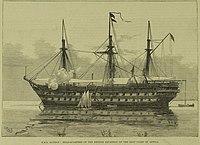Charles Stewart Smith

Charles Stewart Smith JP (born 18 January 1859 – died 23 February 1934) was a British naval officer and diplomat, who was actively involved in the suppression of the slave trade in East Africa and held consular positions there and in Spain and Russia.
Early life[edit]
He was born in London on 18 January 1859, the fourth son of Archibald Smith of Jordanhill (son of James Smith of Jordanhill) and his wife, Susan Emma Parker.
[edit]
At the age of 12 he joined the Royal Navy training ship HMS Britannia as a cadet, and two years later passed out first in his term, being awarded the Admiralty prize for physics and rated midshipman. His service as a midshipman took him to various parts of the world and included two years on the China Station. He was promoted to sub-lieutenant in 1878. In 1879 he received the Beaufort Testimonial,[1] a naval award for surveying.

In 1879 he was posted to HMS London, the Royal Navy’s depot-ship at Zanzibar for the suppression of the local slave trade. HMS London operated a number of steam cutters (or pinnaces), led by lieutenants to intercept Arab dhows. These dhows smuggled slaves, captured from villages on the mainland, to the islands of Zanzibar and Pemba.

During his patrols Smith, who was promoted lieutenant in 1880, captured seven dhows, rescuing a total of 185 slaves – men, women and children. There is a surviving extract of HMS London’s log from 1880 to 1882, showing his largest rescue – that of 99 slaves on 20 October 1880.[2]
His next appointment was to the battleship HMS Sultan and he was present at the bombardment of Alexandria on 11 July 1882.[3]
Consular Service[edit]
In 1883 he was seconded to the post of Vice-Consul at Zanzibar, under Sir John Kirk (explorer) the Consul-General – a man instrumental in the eradication of slavery in Zanzibar. He returned to England early in 1886 and worked for two years in the Foreign Office. In 1888 he retired from the Royal Navy with the rank of Lieutenant Commander and received a permanent appointment in the British Consular Service, serving successively as Consul in Mombasa (1889-1892), as Consul-General in Bilbao (1894-1900), Consul-General in Odessa (1900-1913),[4] and Consul-General in Barcelona (1913-June 1919).[5]
Anglo-German Boundary in East Africa[edit]

In 1892 he was appointed British Commissioner for the delimitation of the Anglo-German Boundary in Africa, between modern day Kenya and Tanzania. The delineation followed moves by Germany to seize areas of the mainland of East Africa formerly claimed by the Sultan of Zanzibar.[6]
He surveyed the 180-mile line from the sea to Mount Kilimanjaro and was assisted by his younger brother George Edward Smith, who was an officer in the Royal Engineers. Twelve years later George returned to complete the survey of the remaining 300 miles from Kilimanjaro to Lake Victoria. Soon after his return to England in 1893, he went to Berlin to take part in the negotiations regarding the boundary.[7]
Odessa and the Potemkin Uprising[edit]
When he was appointed Consul-General in the Russian port of Odessa in 1900, at the age of 41, he was the youngest Consul-General in the Service.[8] Odessa was the fourth-largest city of Imperial Russia, with a population of approximately 400,000, about a third of whom were Jews. The post was an important one, involving responsibility for eleven (later thirteen) consular districts in southern Russia and around the Black Sea. During his thirteen years in Odessa, he witnessed momentous events that included the Russo-Japanese War of 1904-1905, the mutiny of sailors aboard the Russian Battleship Potemkin anchored off Odessa (28 June 1905), the rioting and massacre that immediately followed the mutiny, and several Odessa pogroms.[9] In one of the worst pogroms of Jews, in early November 1905, he (with support from the French Consul-General), made forceful representations to the Prefect of Odessa, D. B. Neidhart, to re-instate the police to stop the killing. Neidhart had previously ordered the police to withdraw – a move which allowed the looters a free hand to murder and pillage. The next day the pogrom subsided. He reported later to the Foreign Office: “It is quite clear that the late disorders were prepared and worked by the police who openly superintended the work of destruction, looting and murder”. The Russian Deputy Minister of the Interior later admitted to the Duma the complicity of the police.[10]
Family[edit]

On the 28 April 1886 Smith married his second cousin, Anne Georgiana Macaulay (1860-1950). Anne came from a family distinguished in academia and the abolitionist movement. Charles and Anne had nine children:
He retired in 1919 and died at Clent, Worcestershire, on 23 February 1934.
References[edit]
- ↑ ""Beaufort Testimonial"".
- ↑ The Last Time, by James Stewart Smith (Privately Published, 2019), p4. See also HMS London (1840)
- ↑ The Last Time, p5
- ↑ Dearest Jean, Rose Macaulay’s letters to a cousin, by Martin Ferguson Smith (Manchester University Press, 2017) p16
- ↑ Dearest Jean, p21
- ↑ "German East Africa". 17 March 2021 – via Wikipedia.
- ↑ The Last Time, p6
- ↑ The Last Time, p 4
- ↑ Dearest Jean, pp16-17
- ↑ The Last Time, pp17-18
This article "Charles Stewart Smith" is from Wikipedia. The list of its authors can be seen in its historical and/or the page Edithistory:Charles Stewart Smith. Articles copied from Draft Namespace on Wikipedia could be seen on the Draft Namespace of Wikipedia and not main one.
